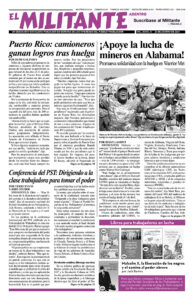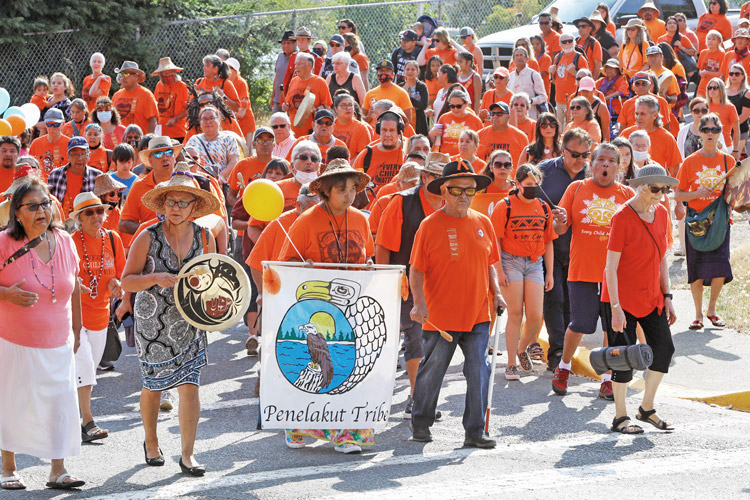SPRINGFIELD, Ohio — A series of classes were part of the Socialist Workers Party International Conference in Springfield, Ohio, July 22-24, most expanding on the central political reports at the gathering. (See article in the Aug. 16 Militant, available at themilitant.com.) An additional class, covered here, was “The Communist Fight to End the Oppression of Native People in Canada.”
Just weeks earlier, tens of thousands marched across Canada to protest the treatment of the country’s Indigenous people following recent discoveries of the remains of more than 1,000 children in unmarked graves. They had been taken from their families by the government in Ottawa and placed in repressive Indian Residential Schools.
“Outrage at Ottawa’s crimes has exposed the bankruptcy of the capitalist rulers,” said Stan Peters, who presented the class along with Pierre Tremblay, leaders of the Communist League in Canada. “The crisis of the ruling rich is not only economic and social, it is also a moral crisis.
“Joining the fight for the liberation of Canada’s 2 million Indigenous people is an essential part of building a mass proletarian revolutionary party capable of leading the working class and its allies to win political power,” Peters said.
“It’s not a separate fight from that of the working class as a whole,” he added. “They are interconnected and will reinforce one another.”
The destruction of Indian land, which was held in common without private ownership, took place in Canada later than it did in the U.S., and had a different history, Peters said.
A bourgeois democratic revolution against British colonial rule in 1837-38 was defeated. Fought primarily by workers, farmers and small artisans from both French and English descent against the British crown, it included demands for equal rights for Natives.
Following that defeat major sectors of the emerging Canadian capitalist class allied with the British rulers to lead the creation of a capitalist state in 1867. Ottawa brutally imposed its dominance over the Indian lands and peoples from the Pacific to the Atlantic coast and institutionalized the oppression of French-speaking Quebecois and Acadians.
In 1876, Tremblay explained, Ottawa established the Indian Act, which still governs relations between the Canadian state and Native peoples. Its goal was to break the resistance of the Indigenous people and enforce the denial of their rights.
“This was essential to Canada’s rulers as they imposed capitalist property and social relations and extended their state from the Atlantic to the Pacific coast,” Peters said. It was a clash between social systems, emerging capitalist rule and an earlier historical form of communal democracy.
In Manitoba the Metis, a mixed Native and Caucasian people, led by Louis Riel, joined by Cree Indians, fought the Canadian army to keep their land. They fought heroically, but were outgunned and their struggle was crushed in 1885. Some 50,000 demonstrated in Montreal against the execution of Riel and other leaders. Ottawa created a system of reserves — small, inhospitable plots of land that Indian First Nations were forced to live on; Native children were seized and forced to attend residential “schools,” whose goal was forced assimilation; and Natives were denied the right to vote.
“The Canadian rulers were never able to destroy the Indigenous people’s spirit of independence, their resistance and their consciousness of their history and culture,” Tremblay said.
To this day, Ottawa maintains the Indian Act and the reserve system. It determines who is and who isn’t an Indian, and can revoke decisions taken by local councils on the reserves.
The act is “a denial of the Indigenous people’s right to self-determination and sovereignty,” Tremblay said. “The Communist League demands its repeal.”
Demands for recognition of Indigenous people’s land claims and treaty rights have been at the center of many hard-fought battles by Native peoples. The Communist League unconditionally supports these struggles.
Today, two-thirds of First Nations people in Canada do not live on reserves. Like most of the Metis and Inuit, a growing majority live in cities and towns and are part of the working class, including a significant number of industrial and construction workers. At the same time, a class differentiation is taking place as a small but growing layer of chiefs become owners of capitalist businesses, exploiting Native and other workers.
Jobs, preferential hiring
Key issues facing Indigenous people today include a high level of unemployment, low wages, discrimination, police brutality and substandard health care and housing.
The Communist League urges our unions to fight for “jobs and preferential hiring for Indigenous people,” Tremblay said, “to strengthen the unity of working people, our unions and their fighting capacity.” The CL ties this to demands for a government-funded public works program to put millions of workers, including Natives, to work at union-scale pay, building the houses, hospitals and infrastructure all working people need.
Native people waged a number of battles — under the impact of the Black-led proletarian fight against Jim Crow segregation in the U.S., the victory of the Cuban Revolution, the Quebecois struggle for national rights and anti-colonial struggles worldwide. They overturned many of the most regressive policies in the Indian Act, Tremblay said, including eventually the abolition of the much-hated residential schools.
Winning the unions to support and lead fights of Native people against their oppression, as well as struggles for women’s rights and battles against all forms of racism, will be a key part of the battle to transform the unions into effective tools to unite the working class and advance our struggles.
Middle-class meritocratic layers, including some who are Indigenous, present an opposite course. Echoing the views of Prime Minister Justin Trudeau, they claim the source of the oppression of Natives is “white settlers,” especially workers and other exploited producers.
“To the contrary,” Peters said, “It is Canada’s capitalist rulers and their government that profit from and maintain this oppression.”
“Communists in Canada advance a proletarian perspective in the fight of Indigenous people against their oppression and exploitation,” Peters concluded, “as we build a party capable of leading the working class and its allies in the revolutionary struggle to overthrow capitalist rule.”
He pointed to the example of the Cuban Revolution, where, with the Marxist leadership of Fidel Castro and other revolutionaries, workers and farmers took power and established their own government. This provided the most powerful tool possible for them to wage the fight to end all forms of oppression and exploitation.


